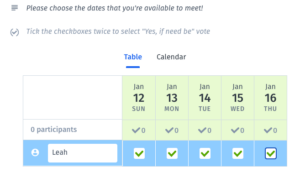
Hosting
Hosting Best Practices
By Leah Jalfon, MHWOW Program Manager
I’ve worked for MHWOW since August 2017, and I became a host in October 2017. Since then I’ve learned a lot about hosting, so I wanted to share some best practices. I hope you’ll find something here that can help you whether you’re just starting out or you’re a seasoned professional. Have something to add? Email me at leah.jalfon@memglobal.org!
 There are so many ways to invite people these days – text, email, Facebook event, Facebook message, GroupMe, etc. Whichever methods you choose, I’ve seen the most success with personal invites. It goes a long way for someone to know that you value them. Here’s an example of a text invite you could send:
“Hey Dani! I want to invite you to a Tu B’Shvat hike I’m hosting next Saturday. We’ll be hiking in Pisgah National Forest, having a delicious picnic, and discussing the holiday. I’d love to have you there because I think your passion about protecting our forests is going to bring a lot to the discussion. Plus, the trail is beautiful! I’m really excited to show it to you. And don’t worry – I’ll have plenty of dairy-free options for you at the picnic!”
I also create a Facebook event so that I can post the location, parking details, memes or gifs to get people excited, and information about MHWOW. In order to minimize people bailing at the last minute, I include something like this in my event description:
“This program is funded by MHWOW, and the funding is based on how many people attend, so no worries if you can’t make it – just keep your RSVP up to date. Thanks!”
Make sure you send another reminder a few days before the program to get a final headcount. If you’re worried about timing, include a schedule like this example for a dinner and discussion:
6:00-6:30: Arrival and fill up your plate
6:30-7:30: Discussion and group share
7:30-8:00: Stay and hang out if you want!
The idea behind this is to minimize the number of people showing up once the discussion has started and also to give people an “out.” You can give people the option to leave at the appointed time while also assuring people that if they’d like to continue talking then they can feel free.
3. Plan your menu
Make sure you ask each person about their dietary restrictions before the program. Avoid posing the question in a group message or Facebook event so you don’t single people out.
Shop in advance and keep it simple. Make it a potluck if you need to! Even if you only request reimbursement for your dish, that’s still an MHWOW program. Make sure to label all the food at your program so people know what they’re getting.
There are so many ways to invite people these days – text, email, Facebook event, Facebook message, GroupMe, etc. Whichever methods you choose, I’ve seen the most success with personal invites. It goes a long way for someone to know that you value them. Here’s an example of a text invite you could send:
“Hey Dani! I want to invite you to a Tu B’Shvat hike I’m hosting next Saturday. We’ll be hiking in Pisgah National Forest, having a delicious picnic, and discussing the holiday. I’d love to have you there because I think your passion about protecting our forests is going to bring a lot to the discussion. Plus, the trail is beautiful! I’m really excited to show it to you. And don’t worry – I’ll have plenty of dairy-free options for you at the picnic!”
I also create a Facebook event so that I can post the location, parking details, memes or gifs to get people excited, and information about MHWOW. In order to minimize people bailing at the last minute, I include something like this in my event description:
“This program is funded by MHWOW, and the funding is based on how many people attend, so no worries if you can’t make it – just keep your RSVP up to date. Thanks!”
Make sure you send another reminder a few days before the program to get a final headcount. If you’re worried about timing, include a schedule like this example for a dinner and discussion:
6:00-6:30: Arrival and fill up your plate
6:30-7:30: Discussion and group share
7:30-8:00: Stay and hang out if you want!
The idea behind this is to minimize the number of people showing up once the discussion has started and also to give people an “out.” You can give people the option to leave at the appointed time while also assuring people that if they’d like to continue talking then they can feel free.
3. Plan your menu
Make sure you ask each person about their dietary restrictions before the program. Avoid posing the question in a group message or Facebook event so you don’t single people out.
Shop in advance and keep it simple. Make it a potluck if you need to! Even if you only request reimbursement for your dish, that’s still an MHWOW program. Make sure to label all the food at your program so people know what they’re getting.

Before Your Program
1. Set your intention What do you want to achieve in your 3 years as an MHWOW host? Think of your “why” before your “what” so that you create programs you’re proud of. Here are some questions to get you thinking.- Do you want to create a tradition, such as a Shabbat dinner every first Friday of the month or a Jewish meditation group? Or do you want to experiment with different program types, like a community service project, a Jewish cooking class, or a book club?
- Do you want to bring new people into your circle, or do you want to deepen your existing relationships?
- Do you want to engage a specific group of people, such as male-identifying individuals, artists, Conservative Jews, or LGBTQ+ people?
 Tyler Jaffe, Blueberry Picking and Sustainability Discussion, Birmingham AL
Tyler Jaffe, Blueberry Picking and Sustainability Discussion, Birmingham AL
 There are so many ways to invite people these days – text, email, Facebook event, Facebook message, GroupMe, etc. Whichever methods you choose, I’ve seen the most success with personal invites. It goes a long way for someone to know that you value them. Here’s an example of a text invite you could send:
“Hey Dani! I want to invite you to a Tu B’Shvat hike I’m hosting next Saturday. We’ll be hiking in Pisgah National Forest, having a delicious picnic, and discussing the holiday. I’d love to have you there because I think your passion about protecting our forests is going to bring a lot to the discussion. Plus, the trail is beautiful! I’m really excited to show it to you. And don’t worry – I’ll have plenty of dairy-free options for you at the picnic!”
I also create a Facebook event so that I can post the location, parking details, memes or gifs to get people excited, and information about MHWOW. In order to minimize people bailing at the last minute, I include something like this in my event description:
“This program is funded by MHWOW, and the funding is based on how many people attend, so no worries if you can’t make it – just keep your RSVP up to date. Thanks!”
Make sure you send another reminder a few days before the program to get a final headcount. If you’re worried about timing, include a schedule like this example for a dinner and discussion:
6:00-6:30: Arrival and fill up your plate
6:30-7:30: Discussion and group share
7:30-8:00: Stay and hang out if you want!
The idea behind this is to minimize the number of people showing up once the discussion has started and also to give people an “out.” You can give people the option to leave at the appointed time while also assuring people that if they’d like to continue talking then they can feel free.
3. Plan your menu
Make sure you ask each person about their dietary restrictions before the program. Avoid posing the question in a group message or Facebook event so you don’t single people out.
Shop in advance and keep it simple. Make it a potluck if you need to! Even if you only request reimbursement for your dish, that’s still an MHWOW program. Make sure to label all the food at your program so people know what they’re getting.
There are so many ways to invite people these days – text, email, Facebook event, Facebook message, GroupMe, etc. Whichever methods you choose, I’ve seen the most success with personal invites. It goes a long way for someone to know that you value them. Here’s an example of a text invite you could send:
“Hey Dani! I want to invite you to a Tu B’Shvat hike I’m hosting next Saturday. We’ll be hiking in Pisgah National Forest, having a delicious picnic, and discussing the holiday. I’d love to have you there because I think your passion about protecting our forests is going to bring a lot to the discussion. Plus, the trail is beautiful! I’m really excited to show it to you. And don’t worry – I’ll have plenty of dairy-free options for you at the picnic!”
I also create a Facebook event so that I can post the location, parking details, memes or gifs to get people excited, and information about MHWOW. In order to minimize people bailing at the last minute, I include something like this in my event description:
“This program is funded by MHWOW, and the funding is based on how many people attend, so no worries if you can’t make it – just keep your RSVP up to date. Thanks!”
Make sure you send another reminder a few days before the program to get a final headcount. If you’re worried about timing, include a schedule like this example for a dinner and discussion:
6:00-6:30: Arrival and fill up your plate
6:30-7:30: Discussion and group share
7:30-8:00: Stay and hang out if you want!
The idea behind this is to minimize the number of people showing up once the discussion has started and also to give people an “out.” You can give people the option to leave at the appointed time while also assuring people that if they’d like to continue talking then they can feel free.
3. Plan your menu
Make sure you ask each person about their dietary restrictions before the program. Avoid posing the question in a group message or Facebook event so you don’t single people out.
Shop in advance and keep it simple. Make it a potluck if you need to! Even if you only request reimbursement for your dish, that’s still an MHWOW program. Make sure to label all the food at your program so people know what they’re getting.
During Your Program
1. KEEP CALM. If you only take away one thing from this list, I hope it’s this. Your friends are coming because they care about you. They will be fine if the food isn’t perfect. If they see you stressing, it will totally change the vibe of your program. 2. Welcome your guests Try to greet each person as they come in. Ask if they would like a drink and offer to hang to their coat (not applicable to my friends in San Diego, which they love to remind me). You can ask a close friend or two to come early so each person arriving has someone to talk to while you greet the next person. Leave some things unfinished as your friends are arriving. This will avoid any awkwardness at the beginning because people will have tasks to do together. They can finish making a salad, setting up furniture, or lighting candles. Once most people have arrived, introduce yourself, tell people what’s going to happen and what you hope they will get out of it. Ask everyone to introduce themselves and consider asking people to share their pronouns. I always think it’s worth the time to do an icebreaker before moving into the activity (feel free to ask us for ideas). Check out these great facilitation tips from Retreatology for leading discussions. 3. Get photos and participant info
Michael Braun, Havdallah, New York City
Don’t forget to take three good photos and gather your participant information! I think it’s easiest to explain MHWOW at your program so people understand why you’re taking pictures and asking for their info. Here’s what I say:
“This program is funded by Moishe House Without Walls, a nonprofit that supports Jewish community building for young adults. In order to get reimbursed for the delicious food we had tonight, I need to take three pictures of all of us, and I’ll also need you to enter your names and emails into the app. Don’t worry, they have never and will never use your emails for anything! It’s just to count how many people were here. Thanks everyone!” I open the Moishe House app on my phone (always make sure you’re using the most updated version), ask people to enter in their contact info, and pass it to the next person. If it’s Shabbat, I’ll follow up with everyone afterwards to get their information.